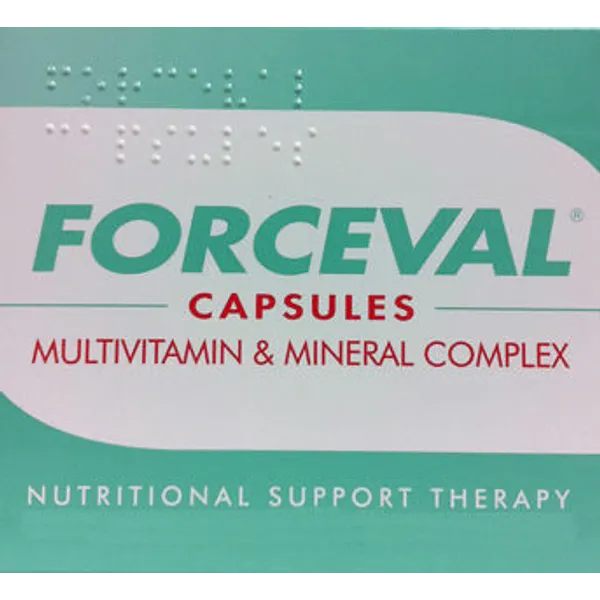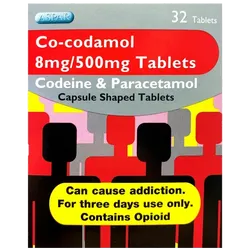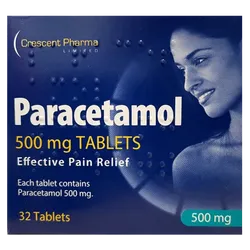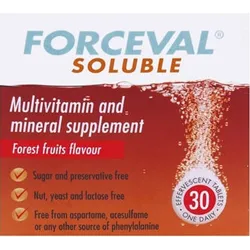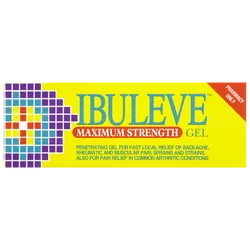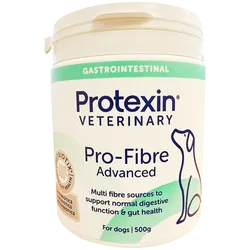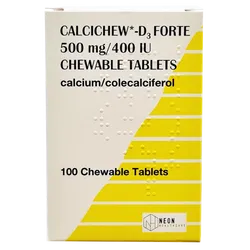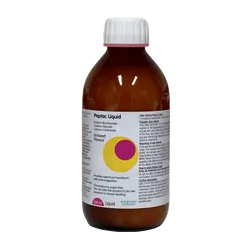Forceval Capsules can be used for the following indications:
1. As a therapeutic nutritional adjunct where the intake of vitamins and minerals is suboptimal, e.g. in the presence of organic disease such as malignancy and immune deficiency syndromes, such as AIDS.
2. As a therapeutic nutritional adjunct in conditions where the absorption of vitamins and minerals is suboptimal, e.g. malabsorption, inflammatory bowel disease and fistulae, short bowel syndrome and Crohn's disease, and where concurrent medication decreases vitamin and mineral absorption.
3. As a therapeutic nutritional adjunct in convalescence from illness, e.g. where anorexia or cachexia exists and following chemo- or radio-therapy.
4. As a therapeutic nutritional adjunct in convalescence from surgery, e.g. where nutritional intake continues to be inadequate.
5. As a therapeutic nutritional adjunct for patients on special or restricted diets, e.g. in renal diets and where several food groups are restricted in therapeutic weight reducing diets.
6. As a therapeutic nutritional adjunct where food intolerance exists, e.g. exclusion diets.
7. As an adjunct in synthetic diets, e.g. in phenylketonuria, galactosaemia and ketogenic diets.
The following account summarises the pharmacological effects of the vitamins and minerals in Forceval Capsules and describes the conditions caused by deficiency of these.
Vitamin A
Vitamin
A plays an important role in the visual process. It is isomerised to
the 11-cis isomer and subsequently bound to the opsin to form the
photoreceptor for vision under subdued light. One of the earliest
symptoms of deficiency is night blindness which may develop into the
more serious condition xerophthalmia. Vitamin A also participates in the
formation and maintenance of the integrity of epithelial tissues and
mucous membranes. Deficiency may cause skin changes resulting in a dry
rough skin with lowered resistance to minor skin infections. Deficiency
of Vitamin A, usually accompanied by protein-energy malnutrition, is
linked with a frequency of infection and with defective immunological
defence mechanisms.
Vitamin D
Vitamin D is required for the absorption of calcium and phosphate from the gastro-intestinal tract and for their transport. Its involvement in the control of calcium metabolism and hence the normal calcification of bones is well documented. Deficiency of Vitamin D in children may result in the development of rickets.
Vitamin B1 (Thiamine)
Thiamine (as the coenzyme, thiamine pyrophosphate) is associated with carbohydrate metabolism. Thiamine pyrophosphate also acts as a coenzyme in the direct oxidative pathway of glucose metabolism. In thiamine deficiency, pyruvic and lactic acids accumulate in the tissues. The pyruvate ion is involved in the biosynthesis of acetylcholine via its conversion to acetyl co-enzyme A through a thiamine-dependent process. In thiamine deficiency, therefore, there are effects on the central nervous system due either to the effect on acetylcholine synthesis or to the lactate and pyruvate accumulation. Deficiency of thiamine results in fatigue, anorexia, gastro-intestinal disturbances, tachycardia, irritability and neurological symptoms. Gross deficiency of thiamine (and other Vitamin B group factors) leads to the condition beri-beri.
Vitamin B2 (Riboflavine)
Riboflavine is phosphorylated to flavine mononucleotide and flavine adenine dinucleotide which act as co-enzymes in the respiratory chain and in oxidative phosphorylation. Riboflavine deficiency presents with ocular symptoms, as well as lesions on the lips and at angles of the mouth.
Vitamin B6 (Pyridoxine)
Pyridoxine, once absorbed, is rapidly converted to the co-enzymes pyridoxal phosphate and pyridoxamine phosphate which play an essential role in protein metabolism. Convulsions and hypochromic anaemia have occurred in infants deficient in pyridoxine.
Vitamin B12 (Cyanocobalamin)
Vitamin B12 is present in the body mainly as methylcobalamin and as adenosylcobalamin and hydroxocobalamin. These act as co-enzymes in the trans methylation of homocysteine to methionine; in the isomerisation of methylmalonyl coenzyme to succinyl co-enzyme and with folate in several metabolic pathways respectively. Deficiency of Vitamin B12 interferes with haemopoiesis and produces megaloblastic anaemia.
Vitamin C (Ascorbic Acid)
Vitamin C cannot be synthesised by man therefore a dietary source is necessary. It acts as a cofactor in numerous biological processes including the hydroxylation of proline to hydroxyproline. In deficiency, the formation of collagen is, therefore, impaired. Ascorbic acid is important in the hydroxylation of dopamine to noradrenaline and in hydroxylations occurring in steroid synthesis in the adrenals. It is a reducing agent in tyrosine metabolism and by acting as an electron donor in the conversion of folic acid to tetrahydrofolic acid is indirectly involved in the synthesis of purine and thymine. Vitamin C is also necessary for the incorporation of iron into ferritin. Vitamin C increases the phagocytic function of leucocytes; it possesses anti-inflammatory activity and it promotes wound healing. Deficiency can produce scurvy. Features include swollen inflamed gums, petechial haemorrhages and subcutaneous bruising. The deficiency of collagen leads to development of thin watery ground substances in which blood vessels are insecurely fixed and readily ruptured. The supportive components of bone and cartilage are also deficient causing bones to fracture easily and teeth to become loose. Anaemia commonly occurs probably due to Vitamin C's role in iron metabolism.
Vitamin E
Vitamin E deficiency has been linked to disorders such as cystic fibrosis where fat absorption is impaired. It is essential for the normal function of the muscular system and the blood.
Nicotinamide
The biochemical functions of nicotinamide as NAD and NADP (nicotinamide adenine dinucleotide phosphate) include the degradation and synthesis of fatty acids, carbohydrates and amino acids as well as hydrogen transfer. Deficiency produces pellagra and mental neurological changes.
Calcium (Dicalcium Phosphate)
Calcium is an essential body electrolyte. It is involved in the maintenance of normal muscle and nerve function and essential for normal cardiac function and the clotting of blood. Calcium is mainly found in the bones and teeth. Deficiency of calcium leads to rickets, osteomalacia in children and osteoporosis in the elderly.
Phosphorus (Dicalcium Phosphate)
Phosphate plays important roles in the osteoblastic and osteoclastic reactions. It interacts with calcium to modify the balance between these two processes. Organic phosphate esters play a key role in the metabolism of carbohydrates, fats and proteins and in the formation of 'high energy phosphate' compounds. Phosphate also acts as a buffer and plays a role in the renal excretion of sodium and hydrogen ions.
Pantothenic Acid
Pantothenic acid is incorporated into co-enzyme A and is involved in metabolic pathways involving acetylation which includes detoxification of drug molecules and biosynthesis of cholesterol, steroid hormones, mucopolysaccharides and acetylcholine. CoA has an essential function in lipid metabolism.
Folic Acid
Folic acid is reduced in the body to tetrahydrofolate which is a co-enzyme for various metabolic processes, including the synthesis of purine and pyrimidine nucleotides and hence in the synthesis of DNA. It is also involved in some amino acid conversion and in the formation and utilisation of formate. Deficiency of folic acid leads to megaloblastic anaemia.
Vitamin H (d-Biotin)
Biotin is a co-enzyme for carboxylation during the metabolism of proteins and carbohydrates.
Selenium
Selenium is an essential trace element, deficiency of which has been reported in man. It is thought to be involved in the functioning of membranes and the synthesis of amino acids. Deficiency of selenium in the diet of experimental animals produces fatty liver followed by necrosis.
Iron
Iron, as a constituent of haemoglobin, plays an essential role in oxygen transport. It is also present in the muscle protein myoglobin and in the liver. Deficiency of iron leads to anaemia.
Copper (Copper Sulphate)
Traces of copper are essential to the body as constituents of enzyme systems involved in oxidation reactions.
Magnesium (Magnesium Oxide)
Magnesium is essential to the body as a constituent of skeletal structures and in maintaining cell integrity and fluid balance. It is utilised in many of the functions in which calcium is concerned but often exerts the opposite effect. Some enzymes require the magnesium ion as a co-factor.
Potassium (Potassium Sulphate)
Potassium is the principle cation of intracellular fluid and is intimately involved in the cell function and metabolism. It is essential for carbohydrate metabolism and glycogen storage and protein synthesis and is involved in transmembrane potential where it is necessary to maintain the resting potential in excitable cells. Potassium ions maintain intracellular pH and osmotic pressure. Prolonged or severe diarrhoea may lead to potassium deficiency.
Zinc (Zinc Sulphate)
Zinc is a constituent of many enzymes and is, therefore, essential to the body. It is present with insulin in the pancreas. It plays a role in DNA synthesis and cell division. Reported effects of deficiency include delayed puberty and hypogonadal dwarfism.
Manganese (Manganese Sulphate)
Manganese is a constituent of enzyme systems including those involved in lipid synthesis, the tricarboxylic acid cycle and purine and pyrimidine metabolism. It is bound to arginase of the liver and activates many enzymes.
Iodine (Potassium Iodide)
Iodine is an essential constituent of the thyroid hormones.
Chromium (Chromium Amino Acid Chelate 10%)
Chromium is an essential trace element involved in carbohydrate metabolism.
Molybdenum (Sodium Molybdate)
Molybdenum is an essential trace element although there have been no reports of deficiency states in man. Molybdenum salts have been used to treat copper poisoning in sheep.
